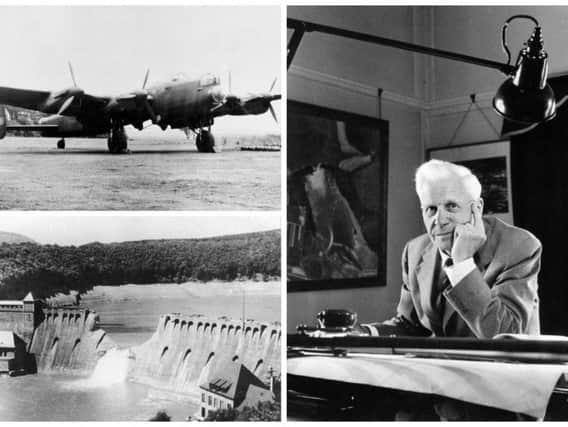GALLERY: 75 years since the Dambusters Raid - celebrating Lancashire's key role


Today marks the 75th anniversary of the famous Dambusters Raid, which was immortalised on the silver screen in 1955. Lancashire played a significant part in the operation as it is widely accepted the explosive mines were filled at ROF Chorley and inspected there by the Commanding Officer, Guy Gibson.
Operation Chastise was carried out during May 16/17 1943 by specially assembled crews of the RAF’s 617 Squadron. They had been practising for months with a new technology which required some experimental flying, navigational, and bomb aiming methods to deliver a payload of the now famous bouncing bomb.
Advertisement
Hide AdAdvertisement
Hide AdConfident they could pull off the aerial feat, the 19 Lancaster Bombers set off from RAF Scampton, in Lincolnshire, bound for the dams of the industrial Ruhr Valley of Germany.
The aim of the raid was to seriously disrupt German productivity and bring about a much-needed morale boost and propaganda opportunity for the Allies.
It was known that if the dams could be breached, the German war machine could potentially grind to a halt in that area and take weeks, if not months, to re-establish.
However, in order to blow up the dams, a new, specifically designed bomb would be required.
Advertisement
Hide AdAdvertisement
Hide AdThe bouncing bomb, or Upkeep Mine, was the brainchild of Barnes Wallis, who was Assistant Chief Designer for Vickers.
It was developed from his earthquake bomb concept which relied upon the ordnance being able to penetrate deep into the ground prior to exploding, in order to cause maximum destruction through seismic forces.
Consequently, the Upkeep Mine was developed to have the potential to detonate close to the weakest part of the dam wall and the explosion and subsequent seismic wave and water pressure would cause the breach.
The “bouncing bombs”, shaped like oil drums, were filled with Torpex, weighing over 6,000 lbs when full.
Advertisement
Hide AdAdvertisement
Hide AdBefore being released the bomb was spun by an electric motor, and once it reached the dam wall it sank and became a mine, exploding at a certain depth.
The squadron only took delivery of the bombs for the raid on May 13 and it is thought the bombs must have been filled at ROF Chorley relatively close to that date but with enough time for
Gibson to have possibly paid a visit to Chorley to see the bombs for himself.
In all, 120 Upkeep mines (originally referred to as the Vickers Type 464) were constructed, although only 58 of them were filled with explosives. It is believed the bombs were filled in building 8 C 24 at ROF Chorley and that large metal rings remained fixed to the walls in the entrance to the building for years to come. These were said to be for chaining the bombs securely to the wall to keep them stable.
Advertisement
Hide AdAdvertisement
Hide AdToday’s opinion is that although the dams were breached and caused great disruption to Germany’s war effort, bringing about a morale boost to the Allies, it did not have as much of an impact on the war industry as was hoped for at the time.
However, there have been many observations made to measure the success of the raids by considering the subsequent events.
For example, construction workers were diverted to repair the dams rather than continue fortifying the Atlantic wall, which was the German defence line that the Allies faced on D-Day in 1944.
The success of the bombs encouraged the powers that be to allow Wallis to continue working on his earthquake bombs.
Advertisement
Hide AdAdvertisement
Hide AdUltimately, the Tallboy and Grand Slam bombs, developed by Wallis after the raid, were responsible for destroying Hitlers V-2 rocket complexes, U-Boat pens in Brest and sank the dreaded Tirpitz in 1944.
During the May 1943 raid, eight of the 19 Lancaster bombers crashed or were shot down and this resulted in the deaths of 53 of the 133 airmen.
Following the war one of the famous dambusters, Flight Lieutenant Edward ‘Johnny’ Johnson, made his home in Blackpool.
Mr Johnson had only joined 617 Squadron in March 1943 and was part of the crew which blew the middle out of the Eder dam during the attack on the night of August 15/16 that year.
Advertisement
Hide AdAdvertisement
Hide AdHe was awarded the Distinguished Flying Cross for his actions.
However, his next major mission with 617 Squadron ended with the crew having to bale out of the burning plane after being sent to attack the Dortmund Ems canal on the night of September 15/16 1943.
Today, only 96-year-old Squadron Leader George ‘Johnny’ Johnson, MBE, DFM survives.
He served as Bomb Aimer on the aeroplane flown by American Pilot ‘Big Joe’ McCarthy and they successfully dropped their bomb against the Sorpe Dam.
Advertisement
Hide AdAdvertisement
Hide AdOver the years, many memorials have been erected in honour of the Dambusters and locations associated with it.
It is no surprise therefore to know Chorley has similarly commemorated the event with certain road names seen in Buckshaw Village.
Located around the site of the bomb filling building are the roads Barnes Wallis Way, Gibson Drive, Lancaster Way and Ordnance Road.